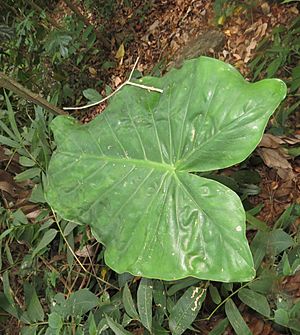Alocasia fornicata facts for kids
Quick facts for kids Alocasia fornicata |
|
|---|---|
 |
|
 |
|
| Scientific classification | |
| Genus: |
Alocasia
|
| Species: |
fornicata
|
| Synonyms | |
|
Colocasia fornicata Kunth |
|
Alocasia fornicata is a fascinating plant. It grows in warm, tropical parts of Asia, like Indochina and the Indian subcontinent. This plant is a type of perennial, meaning it lives for many years. It grows from underground stems or tubers. It is known for its large, green leaves that have many veins.
About Alocasia Fornicata
This plant usually grows to be about 2 to 3 feet tall. Its leaf stalks, called petioles, are often a light pink color. The leaves themselves are wide and shaped like a triangle. Alocasia fornicata also has a special stem called a stolon. This stolon grows horizontally, often along the ground.
Where It Grows and How It's Used
You can find Alocasia fornicata growing naturally in countries like Mizoram, Manipur, and Tripura in North East India. People in these areas have a special name for it: Baibing in the Mizo language.
The plant's flower part, called a spadix, is often collected and cooked. It's a popular seasonal vegetable in these regions. Another similar plant, Alocasia affinis, is also eaten. Both are much-loved foods when they are in season.
Why It Can Be Prickly
The Alocasia fornicata plant, including its spadix, contains tiny, needle-shaped crystals. These crystals are made of something called calcium oxalate. They are known as raphides. Scientists believe these tiny needles are a way for the plant to protect itself. They can irritate the mouth and throat of animals that try to eat the plant. This helps keep the plant safe from predators.
See also
 In Spanish: Alocasia fornicata para niños
In Spanish: Alocasia fornicata para niños

